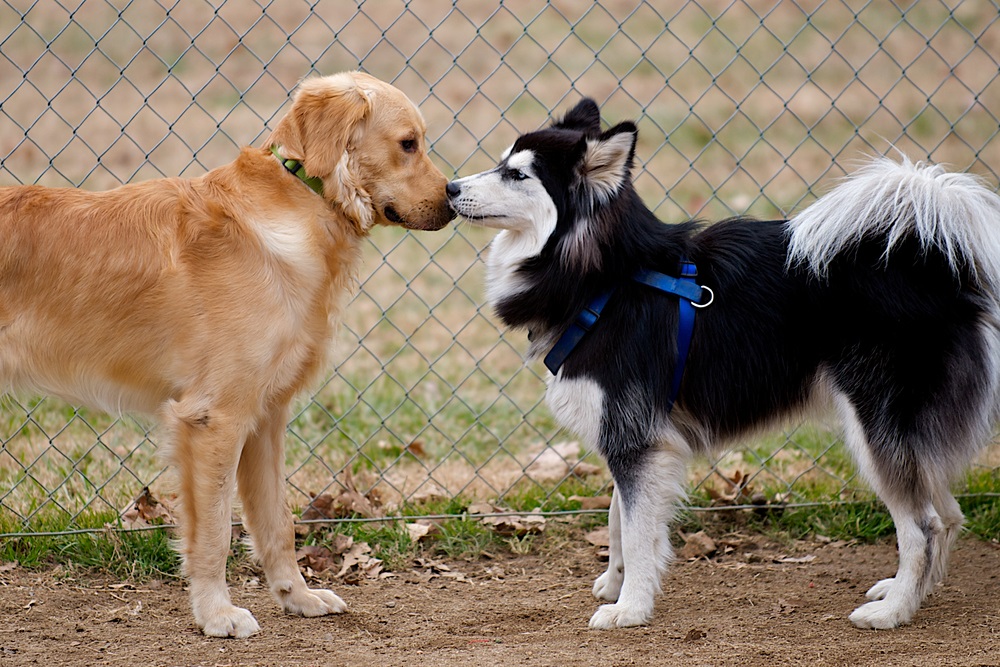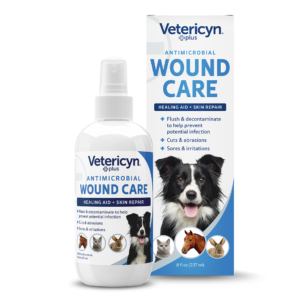Dogs love to run, play, and explore the world. But just like humans, they can have problems with their main exploring tools – their feet and nose – leading to discomfort and even illness.
We’ll explain the most common issues that affect dog paws, pads, and snouts, what causes them, and how to help your dog feel better.
The Paw and Pad Tag Team
Dogs walk on their toes. Their heels do not touch the ground. Dog toes bear all the weight, so they are reinforced with thick pads to help absorb shock, provide traction, and protect the bones.1,2
Dogs have six pads on each foot: four digital pads, one metacarpal (or metatarsal) pad, and one carpal pad. There are five claws, one for each of the four digits and one, called the dew claw, further up the leg. There is fur on top of and in between a dog’s toes.
Paw and Pad Problems
Canine pododermatitis is inflammation of the skin of the paw. It may involve one, several, or all the feet. It includes non-specific symptoms such as hair loss, itching, nodules between the toes, redness, pain, swelling, and lameness in some cases.3
Allergies, foreign bodies, endocrine diseases, parasites, bacterial and fungal infections, autoimmune diseases, behavioral issues, and cancer may all cause pododermatitis.3,4 Trauma from foreign bodies, burns, scrapes, cuts, or punctures can cause paw and pad problems. Secondary infections may complicate these issues.
Claws for Concern
Dog nails grow constantly. The hard outer nail casing is made of keratin. The inner part of a dog’s nail has a nerve and a blood vessel, called the ‘quick.’ If torn, infected, or otherwise injured, this area will bleed and be painful.5
When nails are too long, they may put pressure on the digits, cause pain, overgrow into the paw pad, and catch on things and tear.
The skin around the nail can be the primary site of infection or trauma. Unlike our nails, dog nails are attached to the bone, and a nail infection can lead to a bone infection, also known as osteomyelitis, which is a serious condition.5
There’s More to That Sniff Than Meets the Snout
A dog’s nose is like a built-in superpower for sniffing things out. The wet, wiggly, leathery-looking outer surface of the dog’s nose is the nasal planum. That’s where air enters and leaves the nostrils.6 The pattern on the nasal planum is unique to every dog, like a fingerprint is to people.7
Inhaled air flows through the inside of the snout in a specific manner, enhancing scent detection. Special odor-sensing nerves and cells make up 30% of a dog’s nose.8,9 The air splits into two streams: one goes to the lungs, and the other to an elaborate odor-detection and deciphering center.6
Dogs also have a vomeronasal organ (VNO), also known as Jacobson’s organ. It’s specially designed to detect chemical signals, such as fragrances and pheromones, which trigger specific behaviors in dogs.9 The dog brain has 40 times more space dedicated to evaluating scents than the human brain does.10
We use dogs’ powerful noses for tasks ranging from finding lost people after only a whiff of clothing to detecting cancer, low blood sugar, and impending seizures.11
Problems with Dog Snouts
Problems like hypopigmentation (lightening of the skin) hyperkeratosis (thick, crusty skin), trauma, and even symptoms of respiratory illness can all show up on a dog’s nose. Sometimes, these changes are harmless, but at other times, they can signal a more significant issue.
Nasal Dermatoses
These issues show up on the nose and muzzle of dogs. Causes vary, including genetic factors, immune system diseases, infections, parasites, cancer, nutrient deficiencies, and neurological disorders.
The symptoms are non-specific and include crusts, flakes, hypopigmentation, ulcers, swelling, hair loss, sneezing, redness, nasal discharge, and a cobblestone appearance to the skin. If at-home care doesn’t work or if other symptoms develop, contact your veterinarian. Further tests may be necessary to identify the cause and determine the most effective treatment.12

Hyperkeratosis: Thickening of the nose and footpads
This occurs when the body overproduces keratin, and the top of the nose, foot pads, and sometimes the elbows develop furry-looking crusts of keratin. It’s not a medical emergency, but it may become infected or harden and crack, causing pain.13
Short-nosed breeds and Labrador Retrievers, Cocker Spaniels, Irish Terriers, and Dogues de Bordeaux are predisposed to hyperkeratosis. There is no cure, but topical treatments can help control symptoms, prevent pain, and reduce the risk of infection.13
Hypopigmentation
Hypopigmentation of the nose, also called ‘snow nose,’ may be breed-associated and seasonal.14 This non-painful condition typically occurs during the colder months and is most common in Golden Retrievers, Labrador Retrievers, Siberian Huskies, and Bernese Mountain Dogs. It usually resolves as the temperature heats up, but it may be permanent.14
Sniffing Out the Serious Stuff
While most of these issues are not emergencies and can be managed at home, it is always best to check with your veterinarian. In some cases, foot and nose problems can be symptoms of immune-mediated disease or cancer.

Snout and About: Final Tips
For most snout, footpad, and paw issues, you can handle things at home. Follow these suggestions:
- Clean cuts and scrapes: Vetericyn’s Pet Wound Care formulations ease the pain and itch while helping to prevent infection. It is safe and non-toxic.
- Moisturize dry pads and snouts: Vetericyn has many effective pet care products for pet owners.
Prevent problems with these pro pointers:
- Check paws regularly
- Avoid hot, cold, or rough surfaces
- Wipe paws after walks
- Feed a healthy diet
- Trim nails
- Groom and bathe
- Visit the vet regularly
Taking care of your dog’s paws, pads, and snout is about keeping them healthy, comfortable, and looking their best. Regular monitoring and care can prevent painful problems. Nose, paw, and pad issues are usually minor, but they can indicate bigger health issues. Keep an eye on these spots and work with your vet to keep your dog happy and healthy! Visit our catalog to learn more about Vetericyn’s health and wellness pet formulations.
 Reviewed by Dr. Kathy Adamson
Reviewed by Dr. Kathy Adamson
Dr. Kathy Adamson earned her bachelor’s degree from the University of Notre Dame and her Doctor of Veterinary Medicine degree from the University of Wisconsin-Madison School of Veterinary Medicine.
She completed a one-year small animal medicine and surgery internship at the North Carolina State College of Veterinary Medicine. Alongside her studies, Kathy worked in a research lab, contributing as an author and co-author to various journal articles.
She has also pursued medical writing and editing certification through the University of Chicago Graham School. Currently, she runs KMA Veterinary & Medical Writing, a freelance medical writing company, serves as the Digital Content Manager for the Greater Chicago Area Chapter of the American Medical Writers Association, is a member of the AMWA Communications Committee, and enjoys writing about healthcare topics for people and their cherished pets.
![]() https://www.linkedin.com/in/kathyadamsondvm/
https://www.linkedin.com/in/kathyadamsondvm/
Sources:
- Miao H, Fu J, Qian Z, Ren L, Ren L. How does the canine paw pad attenuate ground impacts? A multi-layer cushion system. Biology Open. 2017;6(12):1889-1896. doi:10.1242/bio.024828
- Kucera T, Washington A. 8 Common Dog Paw Problems. The Spruce Pets. May 13, 2024. Accessed May 30, 2025. https://www.thesprucepets.com/dog-paw-problems-4584406
- Bajwa J. Canine pododermatitis. Can Vet J. 2016;57(9):991-993.
- Rees C. Differential diagnoses for canine pododermatitis (Proceedings). DVM 360. October 1, 2008. Accessed May 30, 2025. https://www.dvm360.com/authors/christine-rees-dvm-dacvd
- Mitchell SC, Kearley M. First Aid for Broken Nails on Dogs. Accessed May 30, 2025. https://www.petmd.com/dog/care/first-aid-broken-nails-dogs
- Honest Paws. Dog Nose Anatomy: Definition, Parts, and Functions | Honest Paws. honestpaws.com. Accessed May 30, 2025. https://www.honestpaws.com/blogs/health/dog-nose-anatomy
- Choi HI, Lee Y, Shin H, et al. The Formation and Invariance of Canine Nose Pattern of Beagle Dogs from Early Puppy to Young Adult Periods. Animals (Basel). 2021;11(9):2664. doi:10.3390/ani11092664
- Coates J. 8 Dog Nose Facts You Probably Didn’t Know | PetMD. petmd.com. May 28, 2020. Accessed May 30, 2025. https://www.petmd.com/dog/behavior/5-dog-nose-facts-you-probably-didnt-know
- Buzek A, Serwańska-Leja K, Zaworska-Zakrzewska A, Kasprowicz-Potocka M. The Shape of the Nasal Cavity and Adaptations to Sniffing in the Dog (Canis familiaris) Compared to Other Domesticated Mammals: A Review Article. Animals (Basel). 2022;12(4):517. doi:10.3390/ani12040517
- Hunter T, Llera R, Buzhardt L. How Dogs Use Smell to Perceive the World | VCA Animal Hospitals. vcahospitals.com. Accessed May 30, 2025. https://vcahospitals.com/know-your-pet/how-dogs-use-smell-to-perceive-the-world
- AMCteam. How Do Dogs’ Noses Work? The Animal Medical Center. April 30, 2014. Accessed May 30, 2025. https://www.amcny.org/blog/2014/04/30/how-do-dogs-noses-work/
- Kleszynski B. Nasal Dermatoses in Dogs: What Are They and How Are They Diagnosed? Accessed May 30, 2025. https://www.petmd.com/dog/conditions/skin/nasal-dermatoses-dogs-what-are-they-and-how-are-they-diagnosed
- Boldan M. Hyperkeratosis in Dogs. petmd.com. September 22, 2023. Accessed May 30, 2025. https://www.petmd.com/dog/conditions/skin/hyperkeratosis-dogs
- Thebeau J. Seasonal Nasal Hypopigmentation In Dogs – Causes, Treatment And Associated Conditions – Vetster. Vetster Online Vets. June 6, 2023. Accessed May 30, 2025. https://vetster.com/en/conditions/dog/seasonal-nasal-hypopigmentation
